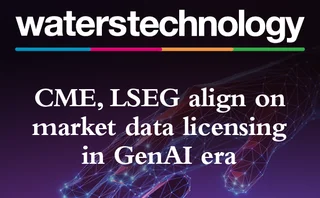Can High Frequency Trading Be Defined?

Earlier this week, US Commodity Futures Trading Commission (CFTC) gathered several wise men to discuss how many angels could dance on the head of a pin. Actually, during the meeting of the regulator's Technology Advisory Committee, the discussion turned to a problem that was, amazingly, similar—how to define high-frequency trading.
Most were there to respond the CFTC commissioner Scott O'Malia's request to help the regulator develop a solid definition that extends beyond “I know it when I see it.”
I've always found it silly to attempt to create objective definitions for things that by definition are subjective, such as high-frequency trading and even best execution. Depending on your perspective, it is difficult to know what is “high-frequency” and what is “best.” The last-place finisher in a 100-meter dash might not be considered fast by Olympic standards, but I know he is certainly faster than I am.
Coming up with an objective definition for high-frequency trading will require selecting arbitrary thresholds. However, those thresholds need to be logical and defensible. In any high-frequency trading conversation the same terms always come up—latency, automation, proximity, aggressiveness and other related words.
As the CFTC's chief economist Andrei Kirilenko mentioned during the committee's discussion, measuring and collecting data on these terms would prove exceedingly complicated.
Kirilenko and his colleagues researched 15,000 trading accounts, examined each account's intraday and end-of-day trading inventory and found that only 16 accounts behaved in what they would term a “high-frequency” manner. In fact, they saw these accounts acting more as "appendages of the matching engine" by providing additional order-matching capabilities. Without them, says Kirilenko, there would be significantly more resting orders on the exchange's order book.
One suggestion, which I believe has merit, comes from Richard Gorelick, CEO of private trading firm RMG Advisors. Gorelick says regulators should avoid establishing arbitrary trading thresholds and look to regulate trades coming from automated trading systems. The data on which orders come from automated trading systems and who runs them is already being collected by exchanges and could be accessed easily by the CFTC if necessary.
No matter what the final definition is, the CFTC will need to make sure that the metrics it relies on are easily measured and collected. But knowing how regulators have worked in the past in developing definitions and standards, I'm not holding my breath.
Only users who have a paid subscription or are part of a corporate subscription are able to print or copy content.
To access these options, along with all other subscription benefits, please contact info@waterstechnology.com or view our subscription options here: https://subscriptions.waterstechnology.com/subscribe
You are currently unable to print this content. Please contact info@waterstechnology.com to find out more.
You are currently unable to copy this content. Please contact info@waterstechnology.com to find out more.
Copyright Infopro Digital Limited. All rights reserved.
As outlined in our terms and conditions, https://www.infopro-digital.com/terms-and-conditions/subscriptions/ (point 2.4), printing is limited to a single copy.
If you would like to purchase additional rights please email info@waterstechnology.com
Copyright Infopro Digital Limited. All rights reserved.
You may share this content using our article tools. As outlined in our terms and conditions, https://www.infopro-digital.com/terms-and-conditions/subscriptions/ (clause 2.4), an Authorised User may only make one copy of the materials for their own personal use. You must also comply with the restrictions in clause 2.5.
If you would like to purchase additional rights please email info@waterstechnology.com
More on Trading Tech
WatersTechnology latest edition
Check out our latest edition, plus more than 13 years of our best content.
The total portfolio approach gains momentum: Building the right tech foundation for success
The rationale for the TPA, and the crucial role technology plays in enabling such an approach
Google, CME say they’ve proved cloud can support HFT—now what?
After demonstrating in September that ultra-low-latency trading can be facilitated in the cloud, the exchange and tech giant are hoping to see barriers to entry come down.
Institutional priorities in multi-asset investing
Private markets, broader exposures and the race for integration
BlackRock and AccessFintech partner, LSEG collabs with OpenAI, Apex launches Pisces service, and more
The Waters Cooler: CJC launches MDC service, Centreon secures Sixth Street investment, UK bond CT update, and more in this week’s news roundup.
TCB Data-Broadhead pairing highlights challenges of market data management
Waters Wrap: The vendors are hoping that blending TCB’s reporting infrastructure with Broadhead’s DLT-backed digital contract and auditing engine will be the cure for data rights management.
Robeco tests credit tool built in Bloomberg’s Python platform
This follows the asset manager’s participation in Bloomberg’s Code Crunch hackathon in Singapore, alongside other firms including LGT Investment Bank and university students.
FCA eyes equities tape, OpenAI and Capco team up, prediction markets gain steam, and more
The Waters Cooler: More tokenization, Ediphy lawsuit updates, Rimes teams up with Databricks, and more in this week’s news roundup.







